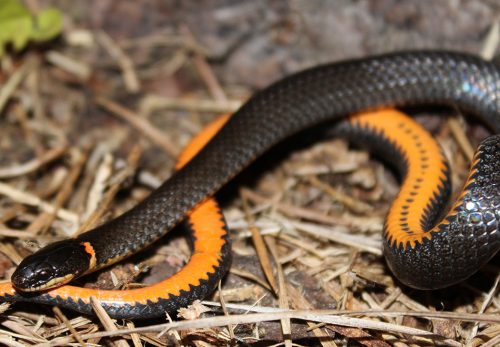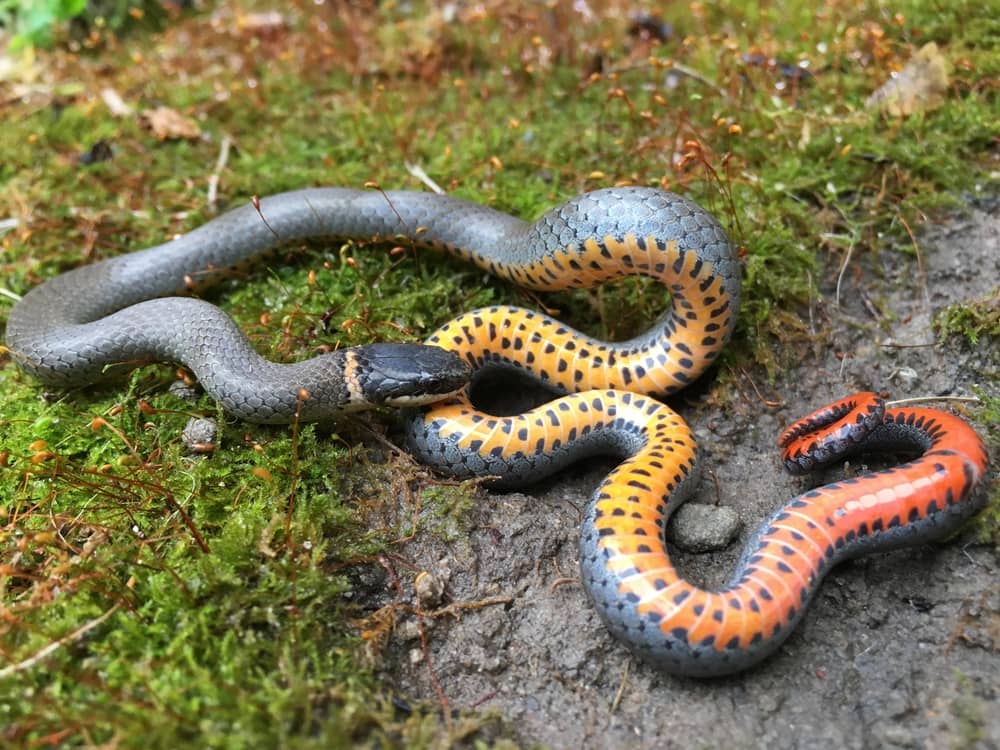
The Southern Ringneck Snake is a terrestrial burrower frequently found in or underneath logs or other debris. Ringneck Snakes are the most frequently found snakes in Florida swimming pools they crawl in to get a drink and then cannot climb out because they are too small to reach the lip of the pool.

Ringneck snakes have smooth scales and round pupils.
Do ring neced snakes climb. Ring-necked Snakes are frequently found in Florida swimming pools. They crawl in to get a drink and then cannot climb out because they are too small to reach the lip of the pool. If you find one in your pool lift it out with the leaf skimmer or a dipnet and release in the woods where it can get back to eating things you do not want in your garden.
The ringneck snake is not overly associated with the ability to climb but this isnt to say that they do not do it at all. If given some small vines and plants in. The ringneck snake is a species of slender mildly poisonous snakes commonly found in southeastern Canada central Mexico and many parts of the US.
Their small stature nonaggressive nature and rear-facing fangs do not pose much threat to the humans. Females are comparatively larger while having shorter tails than the males. The ringneck snake is chiefly terrestrial but it is capable of climbing small trees and shrubs.
Color Size and Attributes The color of the ringneck. Diadophis punctatus commonly known as the ring-necked snake or ringneck snake is a harmless species of colubrid snake found throughout much of the United States central Mexico and southeastern Canada. Ring-necked snakes are secretive nocturnal snakes so are rarely seen during the day time.
They are best known for their unique defense posture of curling up their. Ring-necked snakes occur in a wide variety of habitats. They prefer areas with abundant cover and denning locations.
They can be found within open woodlands near rocky hillsides or in wetter environments with an abundant cover or woody debris within riparian and wet environments especially in more arid habitats. Give your ring necked snake the chance to climb. Although theyre not known for being excellent climbers they do like the opportunity to climb.
Put some vines or branches in their enclosure. This will keep them entertained. The ideal temperature of your ringneck snake enclosure is between 70 and 75 degrees Fahrenheit.
Well strictly speaking ring-necked snakes are nonvenomous. Though they do not have a true venom-producing gland they do have what is called the Duvernoys gland which produces a very mild form of venom that the snake uses to incapacitate its prey while hunting. While these snakes are elusive and shy in the wild they can live in snake colonies of up to 100 other snakes.
This makes them a social creature. Ringnecks talk to each other through touching and nuzzling the head and by releasing pheromones by rubbing against other snakes. They have perceptions of sight touch.
The snakes belly is also a bright yellow or orange color just like the ring on its neck. Ringneck snakes have smooth scales and round pupils. Females are usually larger with a proportionately shorter tail than males.
Hatchlings have very similar colors to adult snakes. Northern ringneck snakes usually have a complete neck ring and a belly without a pattern. Branches might be used by the snakes for climbing and basking.
Does well with potted plants and can be maintained in a naturalistic terrarium. Screen top recommended for good ventilation. Given the size of the Southern Ring-necked Snake its one of the smaller subspecies it seemed to me that a 5-gallon cage would be appropriate.
They are excellent climbers and terrestrial burrower commonly found under logs rocks trees and tree bark. In Florida southern ringneck snakes are the most common snake found in swimming pools they crawl in to get a drink and then cant climb out because they are too small to reach the edge of the pool lip. The Ring-necked snake enjoys a share in the exotic pet trade market.
The snakes drawcard is its cool temperament its interesting patterns and colors and the fact that it has a hint of venom. True they can be caught in the wild but you have to be very knowledgeable about snakes and their habits. Ringneck snakes are according to the Florida Natural History Museum the most frequently found snake in Florida swimming poolsthey crawl in to get a drink and then cannot climb out because they are too small to reach the lip of the pool.
Keep them fully protected and make sure that the enclosure is always closed because Ringneck Snakes can also climb and escape. Keep your backyard grass always short. Avoid keeping piles of leaves large woods and large rocks around your house to keep yourself your family and neighbors protected from snakes.
The ringneck or ring-necked snake is a harmless nocturnal species of snake with a unique and bright color pattern that gives them the appearance of a neck band or ring as their name suggests. Ringneck snakes can be found across large parts of the United States central Mexico as well as Canadas south-eastern region and they love to. Ringneck snakes are according to the Florida Natural History Museum the most frequently found snake in Florida swimming poolsthey crawl in to get a drink and then cannot climb out because they are too small to reach the lip of the pool.
The Southern Ringneck Snake is a terrestrial burrower frequently found in or underneath logs or other debris. Ringneck Snakes are the most frequently found snakes in Florida swimming pools they crawl in to get a drink and then cannot climb out because they are too small to reach the lip of the pool. The tell-tale ring around their neck almost resembles a collar which is a bit ironic.
Ring snakes have tiny fangs in the back of their mouths which contain mild venom for eating purposes. While a ring snake can bite you its not something to expect. You may not even feel it if it were to occur.
485 5 votes Most adult Ring-necked Snakes are about 8-14 inches 21-36 cm in total length. Adults are small and slender with a black or slate gray body and a yellowish ring across the neck which may be incomplete or missing. The belly and underside of the tail are bright yellow orange or red.
Ringneck snake care isnt easy for first-time snake owners because these fragile snakes have very specific habitat types. On the upside these shy stunning animals eat insects rather than small mammals making them a good option for those squeamish about feeding snakes rats or mice.